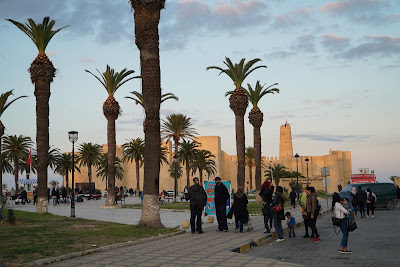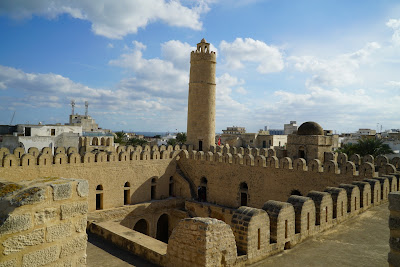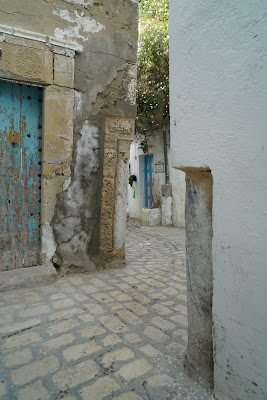Holy Blue
Happy independence day Finland! Today’s entry is very blue and white in honour of the Finnish flag.
I have now headed back to higher ground after spending the last few weeks by the sea. Having finally managed to tear myself away from Houmt Souk and the island of Djerba, I’ve been working my way gradually Northwards via Sfax, Mahdia, Monastir, scouring fortified old towns (medinas) with their narrow twisting streets and Islamic fortreses (ribats) that look like storybook castles.
I have now headed back to higher ground after spending the last few weeks by the sea. Having finally managed to tear myself away from Houmt Souk and the island of Djerba, I’ve been working my way gradually Northwards via Sfax, Mahdia, Monastir, scouring fortified old towns (medinas) with their narrow twisting streets and Islamic fortreses (ribats) that look like storybook castles.
I even dared to take a quick day-trip to check out the medina of Sousse. Sousse is tourist heartland, but I met hardly any - at least Western - travellers. Either low season is really paying off, or else the tourists really do just stay in the zona touristico’s with their beaches, frappuccinos and hamburgers.
But for fear of running out of coast, I’ve now headed inland. First stop was the very holy city of Kairouan, considered the fourth holiest site of Islam, since it houses the oldest mosque in North Africa.
This, the grande mosque, was originally founded in 670 AD, though the oldest part left standing is the minaret from 728 AD.
When buildings are old here, they are really old. And into these already impressively old buildings the remains of even older structures are incorporated. The vandals may have attacked Tunisia at one point in history, but the true vandalisers of old Roman ruins are the Tunisians themselves. For example the great mosque alone has 414 pillars to support the horseshoe arches. They are all plundered from the Roman sites of Carthage and Hadrumetum (Sousse) and consequently no two are alike.
This, the grande mosque, was originally founded in 670 AD, though the oldest part left standing is the minaret from 728 AD.
When buildings are old here, they are really old. And into these already impressively old buildings the remains of even older structures are incorporated. The vandals may have attacked Tunisia at one point in history, but the true vandalisers of old Roman ruins are the Tunisians themselves. For example the great mosque alone has 414 pillars to support the horseshoe arches. They are all plundered from the Roman sites of Carthage and Hadrumetum (Sousse) and consequently no two are alike.
The great mosque has even recycled some old Roman stones with text on them in its walls (some upside down). The texts, curiously enough, tell of the building of a new pagan temple.
And when done with religious monuments, any left over ancient Roman columns make very handy corner posts for the old medina. The way the locals drive, I suppose it is a good idea to enforce house corners in case of collisions.
Another notable religious site in Kairouan is the rather stunning tomb of one of prophet Muhammed’s companions (sahab), Abu Zama el Belaoui.
And when done with religious monuments, any left over ancient Roman columns make very handy corner posts for the old medina. The way the locals drive, I suppose it is a good idea to enforce house corners in case of collisions.
Another notable religious site in Kairouan is the rather stunning tomb of one of prophet Muhammed’s companions (sahab), Abu Zama el Belaoui.
He was commonly called the Barber, since he carried three hairs from the prophet’s beard with him wherever he went - including, one supposes, into the grave.
Leaving one to ponder, how long dna lasts and could one some day clone the prophet from those hairs?
Kairouan also gets the prize for bluest city! Blue is definitely the favourite colour of this country when it comes to decorating houses - but usually the houses are whitewashed with blue windows and doorways.
In Kairouan they go one further, and many of the houses in the old medina are bluewashed!
According to one legend, seven visits to Kairouan equal one visit to Mecca. And since Mecca is clearly off limits to me, this is as close as I’m likely to getting Islamic brownie points.


























Comments